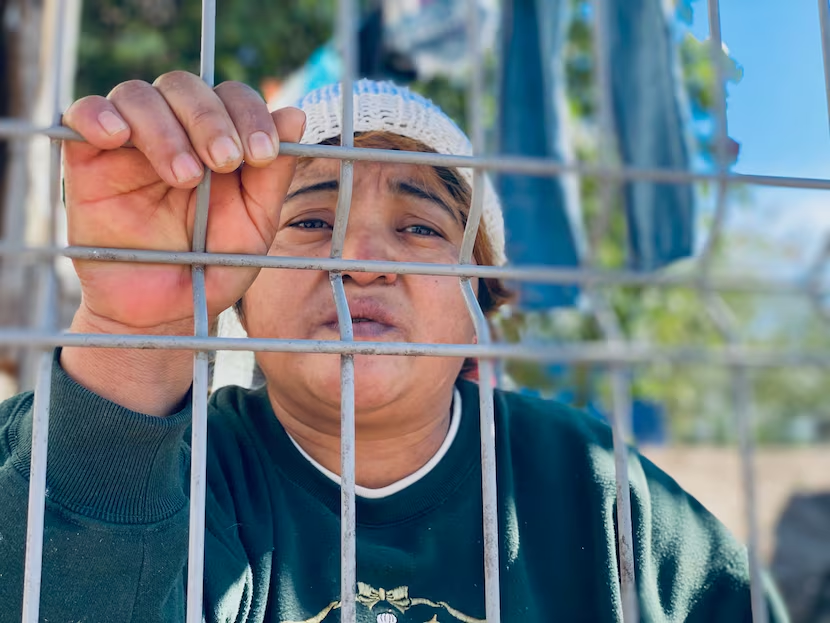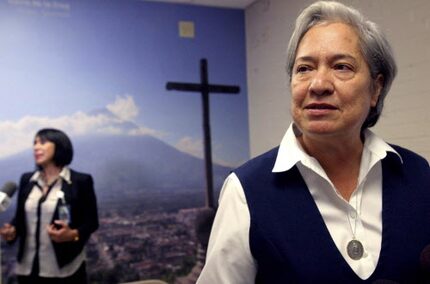MATAMOROS, Mexico --- Ana Sorto clutched the gray metal fencing around the migrant camp here at the muddy banks of the Rio Grande. She’s been waiting 17 months to be admitted into the U.S. as an asylum-seeker fleeing gangs. Her small son, Jimmy Alejandro, has spent nearly half his life in the tent camp.
Her fresh hope, she says, is a man named Joe Biden.
“We’re hopeful President Biden will show us some humanity,” said Sorto as her son, dressed in three pairs of pants on a chilly day, played with a toy.
Biden is unveiling a sweeping immigration proposal for Congress. Other policies will be quickly implemented with the stroke of his pen. The promises of the Biden administration are expansive, but there’s little mention of the thorniest of issues:
The biggest challenge for Biden is the lethal COVID-19 pandemic. And President Donald Trump has used the pandemic to implement a sweeping emergency measure that has resulted in nearly 400,000 rapid “expulsions” of immigrants at the border since March. Immigrants cross the border, are held by authorities and then quickly sent south again often within hours.
The pandemic has allowed Trump to almost completely choke off immigration, including migration from asylum-seekers.
Immigration, civil rights and medical groups are pushing the Biden team to swiftly lift the so-called “Title 42” public health order that has added to the crippling of the asylum process.

Lawyers say it end-runs the legal processes of the immigration courts, and a physicians group notes that it cruelly singles out certain immigrants, rather than all travelers. The policy may also have created a huge revolving door: Many immigrants who cross into the U.S. and are quickly sent back across the border feel they have no choice but to try again and again.
“It’s so discriminatory and egregious to single out a much smaller group of asylum-seekers, who are not any more risk to US public health than in any other category of people,” said Kathryn Hampton, an asylum specialist with Physicians for Human Rights, who noted the uneven application of the emergency order. The medical group supports lifting the order.
A time of change
Biden’s proposals include a pathway to citizenship for many of the nation’s 11 million undocumented immigrants. Separate measures would provide a unification plan for hundreds of children separated at the border from their migrant parents in what’s viewed as the cruelest measure of the Trump years.
The administration also plans to automatically issue green cards for those holding temporary work permits through DACA, Deferred Action for Childhood Arrivals, and for immigrants who have temporary protection status issued during natural disasters and outbreaks of violence. Those two groups, some waiting nearly 20 years, comprise about a million persons.
Civil rights attorneys and activists also want an end to a pre-pandemic program, loosely known as Remain in Mexico, that left about 70,000 asylum-seekers in border cities like Matamoros, where they mostly live in poor and unsafe conditions while waiting for the chance to argue their cases in the U.S.
But the Biden administration hasn’t committed to lifting the public health measure, which is known as Title 42. The incoming administration didn’t respond to inquiries about its plans.
At his Senate confirmation hearing Tuesday morning, Biden’s pick to head the Department of Homeland Security Alejandro Mayorkas dodged a question on Title 42, saying “I look forward to studying” its use. On the Remain in Mexico program, Mayorkas said he would support Biden’s commitment to end it.
“There was never, never a public health justification for these policies,” said Dr. Michele Heisler, the medical director for Physicians for Human Rights. “These were always punitive, illegal, cruel, ideological immigration policies masquerading as public health policies.”
Many physicians say precautions such as screening, masking and social distancing can be used to prevent the coronavirus spread. And the virus is already spreading wildly on both sides of the border.
On the ground in Matamoros, Sister Norma Pimentel, a Roman Catholic nun, worries that change won’t come fast enough. She’s the executive director of Catholic Charities of the Rio Grande Valley and routinely crosses the border bridge into Matamoros to assist the migrants.
“My biggest fear is that the Biden administration won’t do anything to help these families, though I think they have good intentions.”
Biden’s big test will come quickly, the nun predicts. Caravans of thousands of Honduran immigrants have crossed into Guatemala over the weekend.
“We have to be ready for a new humanitarian crisis,” Pimentel said.

Heisler, who has discussed Title 42 with the incoming Biden administration, said she believes change will come, possibly within the first month. But she added, “They’re sensitive to not sending a message that OK, the borders are open.”
Lawyers from the ACLU to Human Rights First to the Haitian Bridge Alliance are calling for repair of the asylum system, starting with the lifting of Title 42 and the end to the pre-pandemic Remain in Mexico program, which has kept 70,000 asylum-seekers in Mexico waiting for their cases to make their way into the immigration courts. About 28,000 people now have cases pending in what’s known officially as the Migration Protection Protocols, according to the Syracuse University nonprofit TRAC.
“The Biden administration can and should reverse all these policies,” said Karen Musalo, the director of the Center for Gender and Refugee Studies at the University of California Hastings College of Law.
Others say lifting the public health order is not so easy because of the way it’s tangled with other processes and policies. A practical issue: Holding immigrants for border processing in a socially distant manner and supplying them with masks and sanitizer.
“The way that the Trump administration put all these things together is that they are overlapping and integrated,” said Theresa Cardinal Brown, director of immigration and cross-border policy at the Bipartisan Policy Center in Washington. “Title 42 is probably the most extreme. It says we will expel you. No process.”
Biden and his team want to reverse many policies, said Brown, who was a policy advisor in the U.S. Customs and Border Protection and the Department of Homeland Security in the administrations of George W. Bush and Barack Obama. But Biden “can’t just flick a switch.”
Physicians for Human Rights notes that use of the emergency powers has been applied unevenly to only certain persons, undermining its alleged purpose of containing the virus’s spread. Reasonable health procedures could be put in place, such as screening asylum-seekers for COVID-19, using face masks and not placing asylum-seekers in detention or other settings where social distancing is not possible.
Millions of other people continue to cross the border every day, by foot or by vehicle, because they are essential workers or they have some other exemption, Hampton said.

The emergency order doesn’t apply to crossings by U.S. citizens, lawful permanent residents, members of the armed forces, and their spouses or children, among others. Pedestrian traffic during the pandemic in 2020 shrunk to a third the 2019 level in Brownsville and El Paso, for example, according to the U.S. Bureau of Transportation Statistics. But Brownsville crossings flowed at a still substantial level of about 1.1 million and, in El Paso at 2.5 million, through September of 2020.
Since the emergency controls were invoked, nearly 400,000 “encounters” have been made, according to the U.S. Customs and Border Protection, or CBP. Half the encounters occurred in fiscal 2020, and the others, about 183,000, happened in the first three months of this fiscal year, through December. The encounters can reflect multiple crossings of the same person, policy experts warn. CBP doesn’t count the interceptions of the immigrants as actual apprehensions, but rather as Title 42 “expulsions.”
“The numbers look artificially high,” said Adam Isacson, a security analyst at the Washington Office on Latin America, an advocacy group. “Holding someone for 90 minutes and then expelling them is inviting them to try again and very often.”
But Isacson emphasized that many of the new border-crossers aren’t only the Central American asylum-seekers of the past. Many are single adults from Mexico, rather than families from Honduras, Guatemala and El Salvador. As hard-hit as the U.S. economy has been by the pandemic, it’s been worse in Latin America, Isacson said.
“It’s people who have been slammed by this economic depression in which Latin America suddenly finds itself,” Isacson.
More caravans
The Biden team says it plans to address the root causes that make people flee their homelands in Central America, where much of the recent immigration has come from. That includes a proposal for a four-year, $4 billion package of assistance for the region, with aid to countries making “measurable reductions in gang and gender-based violence” and anti-corruption measures.
U.S.-bound caravans of migrants, most originating in Honduras, are traveling in numbers that reached up to 8,000, according to the Guatemalan Institute of Migration. About 2,400 were deported back to Honduras, authorities said Tuesday. Others have been met by Guatemalan security forces in southern Guatemala on Sunday, who used sticks and tear gas to beat them back, video reports show.
Back-to-back hurricanes hit Honduras and Guatemala in November, the global pandemic is crushing the economies there, and promises of a less harsh immigration system in the U.S. are believed to be the lure.
At the Matamoros camp, where asylum-seekers are clustered at the edge of this border city of about 520,000, a group of migrants from Honduras and Nicaragua gathered last week. Roberto Valdivia, a Nicaraguan, has been waiting for nearly two years for asylum.
“I know the United States is going through some difficult times, fighting tyranny, something we know well,” Valdivia said. “But it is a great country and immigrants like me want to contribute to its greatness. “
Oscar Borjas, a Honduran asylum-seeker, assists other immigrants at a resource center in a tan office building, just outside the camp. He scrolls through his computer for messages on the latest on the caravans.
“There’s hope that the new administration will get rid of ‘Remain in Mexico,’ but I caution migrants here to be patient,” Borjas said. “This won’t happen overnight. This may take months, maybe a year. But even that is hopeful.”
As for fresh caravans, “I want to say that the journey will be difficult, but who am I to take their dreams away. I, too, came with a dream.”
Staff writer Dianne Solis reported from Dallas and border correspondent Alfredo Corchado reported from Mexico and the Rio Grande Valley.


